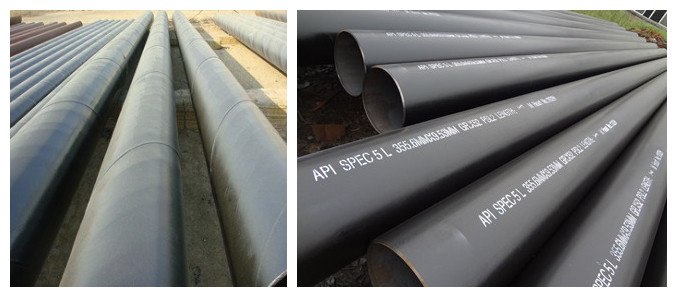
The stainless steel pipe is a kind of hollow long circular steel, mainly used for oil, chemical, medical care, food, light, machinery and instruments industries' transportation pipeline and mechanical parts. Also, it is widely used for the fabrication of mechanical parts, engineering structures, conventional weapons, gun barrel, shells, etc; because it has relative low weight with the same folding strength and torsional strength.
1.
Concentricity
The seamless pipe is manufactured by punching a hole in stainless steel billet at a high temperature of 2200 °f, which the tool steel is softening after punching and drawing, and spirally formed through the hole. It would cause wall unevenness and high eccentricity. Thus ASTM(American Society for Testing Materials) allows the wall thickness of the seamless pipe to be larger than that of
welded pipe. Welded pipe is made by precision cold rolled sheets (4-5 feet per roll). These cold rolled sheets typically have a maximum wall thickness difference of 0.002 inches. The plate is cut into a width of πd, d means the outer diameter of the pipe. The tolerances of welded pipes are very small, and the entire circumference of the wall thickness is very uniform.
2.
Welding Performance
The chemical compositions between welded pipe and
seamless pipe have a certain difference. The component of seamless pipe only meets the basic requirements of ASTM. But the steel that used to produce welded pipe contained chemical composition, which is suitable for welding. For example, silicon, sulfur, manganese, oxygen and triangle ferrite and other elements can be mixed with a certain proportion during the welding process so they can create a welding material to conducting heat, then the entire seam will be complete penetrating. The lack of steel pipe chemical compositions above, for example, the seamless tubes would have a variety of factors of instability during the welding process, it's not easy to weld and won't be penetrating.
3.
The Grain Size
The grain size is involved with the temperature of heat treatment and the time of sustaining the same temperature. The grain of annealing welded stainless steel pipe has the same size grain size with seamless stainless steel pipe. If the welded pipe was dealt with the minimum cold treatment, the grain size of welding line would be smaller than welded metal. Otherwise, it would be the same.
4.
Strength
The strength of the pipeline depends on the alloy composition, therefore, as long as both pipes contains the same alloy and heat treatment, they would have the same strength.
After tensile testing and three-dimensional vibration test, the splitting of welded stainless steel pipe are away from the welded joint and heating area; because the welded joint has low impurities and high nitrogen content so that it has high strength. However, the ASME (American Society of Mechanical Engineers) considered that welded stainless steel pipe can only bear 85% of the allowable pressure, it is mainly due to the collected data which is earlier than improved welding equipment.
ASME stipulated welded stainless pipe can withstand the allowable pressure only when it fully passed the ultrasonic test. Similarly, Europe and Asia also stipulated that the quality of welding performance can be ensured when welded stainless pipe passed the eddy current test. But the test requires the approval of legal procedures and licensed institutions. Trent's eddy current testing gained the permission from the Swedish Ministry of Power. ASME believed small current loss is based on the high quality performance of the welded pipes.
5.
Corrosion Resistance
The intensity of corrosion resistance also depends on the alloy composition. Seamless stainless steel pipes with the same chemical composition have the same corrosion resistance with being fully heat treated welded stainless steel pipes. The supplement test of ASTM proved that the corrosion resistance on welded joint is equal to or superior than welded metal. Under the acidic chloride environment, the corrosion of welded
steel pipe with incomplete heated treatment would accelerate on the welded joint. But that's the requirements of corrosion test, the actual environment isn't so harsh.
6.
Bendability and Ductility
The ductility of welded joint can be tested through the regulations of ASTM: bend to 45°, to 90°, flat it along the welded seam, then repeat above steps to make the inner diameter of welded seam reach to 180°. The approval standards of welded quality is: splitting and intergranular separation don't arise under the circumstance of 40 times magnification. The pipe bending diameter is based on alloy composition; normally the minimum diameter is 2d. The ideal welded condition is between neutral or compression. Besides, the pipe should lower its solidity through annealing treatment in order to improve its bendability.
7.
Price
Welded stainless steel pipes only cost half as much as seamless stainless steel pipes.
8.
Wall Thickness/Diameter
Normally, light gauge stainless pipe of lower wall thickness or small diameter is better to use welding processing. High gauge stainless pipe of high wall thickness or large diameter should use stamping method.
9.
Overall Quality
Generally, the quality of welded stainless steel pipe is superior to seamless stainless steel pipe. Welded stainless steel pipe was made by tested and accurate cold rolled plate so that any defects would only be found in the weld joint. Seamless stainless steel pipe was made by stainless steel through stamping and punching, which means it would cause many splittings in the pipe wall. According to eddy current test, the defective rate of welded stainless steel pipe is normally lower than seamless stainless steel pipe. Ultrasonic test shows that it's difficult to find defects on seamless stainless steel pipe because it has loud background noise, while welded stainless steel pipe is not.


